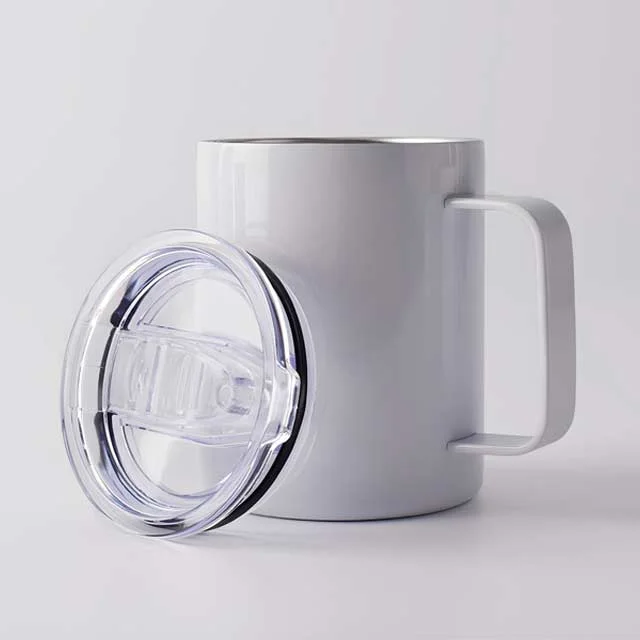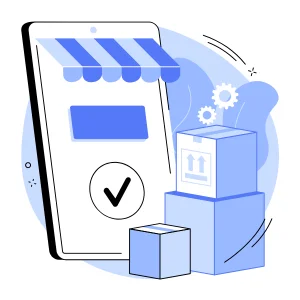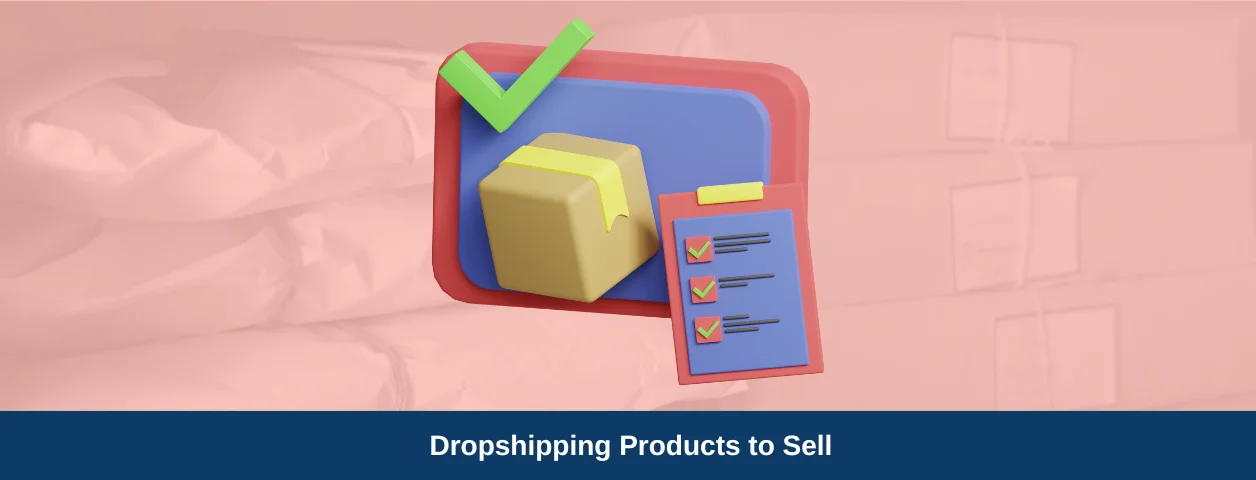Did you know that more than 80% of advertisers allocate their money to affiliate marketing, and 15% of digital media revenue comes from affiliate marketing?
Also, 27% of retailers use drop shipping as their classic primary fulfillment method. Both Affiliate and Dropshipping business models have gained more popularity in recent years.
When comparing dropshipping vs affiliate marketing, which business model gives profitable margins?
In this blog, We are about to take a close look at affiliate marketing vs dropshipping to see not just which one is more profitable but also how they offer ways to earn passive income and their pros and cons.
What is affiliate marketing?

Affiliate marketing is an online commission-based marketing program in which online brands pay businesses to promote their products or services to customers via a unique affiliate link.
When customers purchase a product through this affiliate link, the affiliates earn a commission for every sale.
Affiliates are individuals who promote products through various channels such as social media, blogs, and emails.
Advantages and disadvantages of affiliate marketing
Advantages of Affiliate Marketing
1. Low Start-Up Costs:
Affiliate marketing eliminates the need for upfront investments. There is no manufacturing cost, inventory management, shipping orders, or customer service hassles, so compared to traditional businesses, minimal investment is needed.
Once you set it up, affiliate links can keep making you money even if you’re not actively promoting products. This means you can grow your earnings without constantly working on it.
3. Diverse product options:
It allows access to a diverse range of products and services across various industries, which will result in more customers and sales.
4. Diverse Income Streams:
You can promote products from different industries and niches, like wellness, technology, fashion, and finance. This lets you try out other areas, find what works best for you, and earn money from multiple sources.
5. Flexibility and Work from Anywhere:
Freedom to work from anywhere in the world and flexibility to choose your own schedule allows for a flexible work-life balance and control over your time.
6. Performance-based earnings:
Your income is directly linked to your marketing efforts, rewarding you for successful promotions.
7. Scalability:
With effective strategies, affiliate marketing can be scaled up to reach larger audiences and increase earnings.
Disadvantages of affiliate marketing
1. High Competition:
Promoting products in this competitive market can be challenging for newcomers. This can result in reduced commission rates and difficulty standing out in the crowded marketplace.
2. No control over the product pricing:
Another disadvantage is that you can’t control or negotiate product pricing, which results in less control over commissions.
3. Fraudulent activities:
There is a high chance of fraudulent practices happening, such as providing fake leads to earn commissions instead of helping a business grow ethically.
4. Commission Structure:
Commission rates can vary, with some programs offering low rates or having strict payout terms. It’s essential to review each program’s commission structure and terms before joining.
What is dropshipping?

Dropshipping is a retail fulfillment method in which an online store sells products without owning or handling Inventory, packing, or shipping.
When a customer places an order, the online store(merchant) forwards it to a third-party supplier, who ships the product directly to the customer. Anyone can start a dropshipping business in india without handling inventory and shipping.
Advantages and disadvantages of dropshipping
Advantages of Dropshipping
1. Low Startup Cost and Reduced Ris
One of the biggest advantages of dropshipping is the low startup costs. You only pay for products when a customer orders them, so you don’t have to invest in inventory upfront. This means less risk if a product doesn’t sell.
2. Easier to experiment with different Products:
Dropshipping makes it easier to experiment with different products. You can try out various items and market trends without committing to large bulk orders.
3. Easy to add new products:
Adding new products to your store is simple with dropshipping. There’s a wide range of products available, and you don’t need to keep them in stock or manage inventory. Many drop shippers offer diverse products, so with proper research, you can find the right fit for your store.
4. Location Independence:
You can run a dropshipping business from anywhere with an internet connection, it giving you location independence.
5. Less manpower cost:
Dropshipping requires less manpower since you don’t need physical inventory.
6. There’s no hassle with order fulfillment and shipping:
Order fulfillment and shipping are hassle-free with dropshipping. When a customer places an order, the merchant forwards the order to a third-party supplier who ships the product directly to the customer.
Disadvantages of Dropshipping
1. Less Control:
You have less control over the quality, consistency, and delivery of your products.
2. Limited product Utilization:
While dropshipping offers a wide range of products, you’re limited to what your suppliers have in stock.
3. Potential Issues:
Sometimes you deal with potential issues like order delays, Manual errors, or returns from customer orders.
4. Lack of control over the customer experience:
You have little control over the customer experience, which can be affected by factors like product quality, shipping times, and customer service.
Choose a product to sell on your online store

Dropshipping vs Affiliate Marketing in India 2024
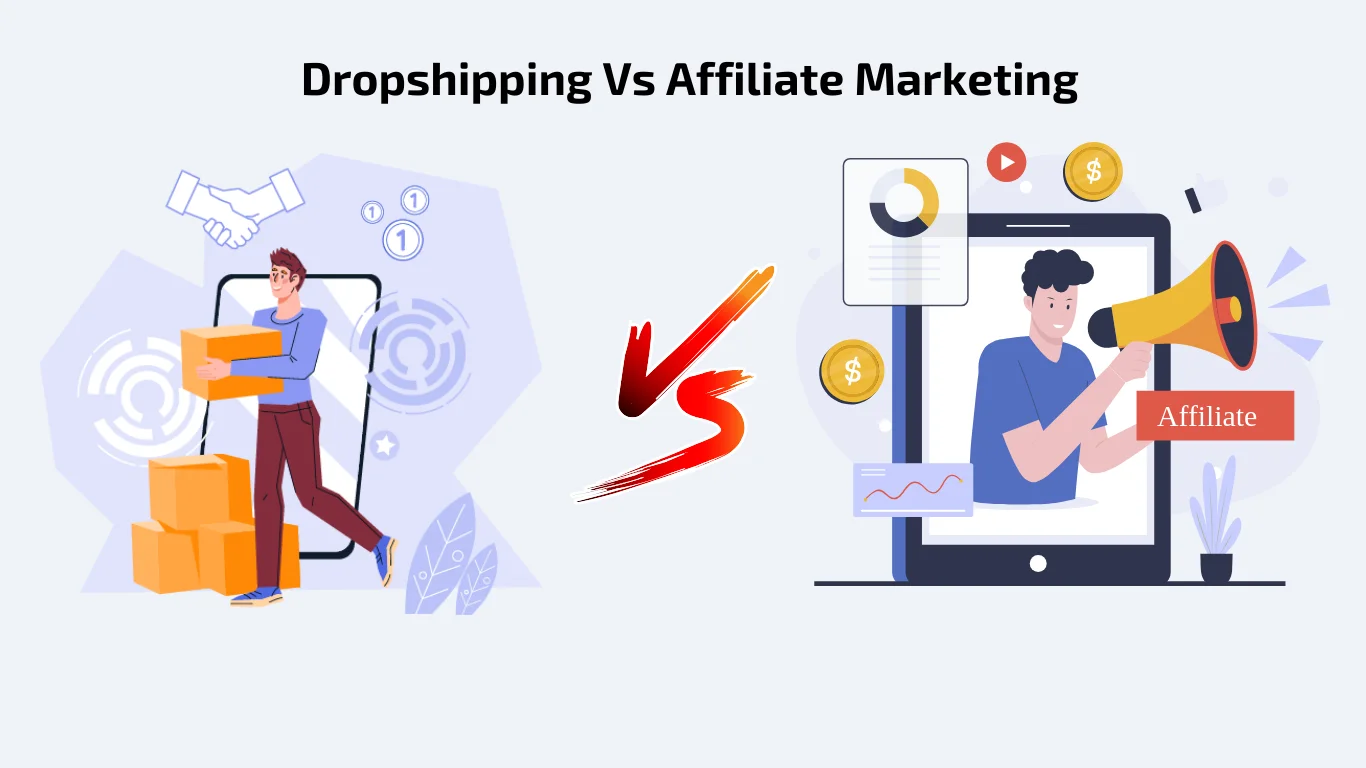
The key difference between dropshipping vs affiliate marketing at a glance:
While dropshipping involves selling products without owning inventory or stock, affiliate marketing earns commissions by promoting other companies’ products.
Difference between dropshipping and affiliate marketing
Aspect | Dropshipping | Affiliate Marketing |
Initial Investment | You don’t have to invest in inventory upfront. | It’s easy to get started, and no upfront investments are needed. |
Inventory Management | You don’t have to manage inventory. Supplier handles everything. | No need for inventory Management |
Challenges | Finding a reliable dropshipping supplier and building brand awareness. | Finding the right program and quality products, as well as building traffic and a targeted audience, are challenging. |
Profit Margins | Your profit margin can range between 15% and 20%, depending on your product selection. | Affiliate programs can offer 5% to 10% commissions on sales and have the potential to generate passive income. |
Customer Support | Need to handle customer support. | You don’t have to be concerned about customer support. |
Control over products | Relay on suppliers for product quality and control. | No control over products. You only have to promote products. |
Control over pricing | You can set your price on dropshipping products. | You can’t negotiate product pricing. |
Scalability | Highly scalable business model. | It is scalable, but it needs a larger audience. |
Risk | Low-risk business model. | There is a risk of potential fraud. |
Example Platforms | Amazon Associates, CJ Affiliate, Flipkart Affiliate |
Which one is profitable? - dropshipping vs affiliate marketing
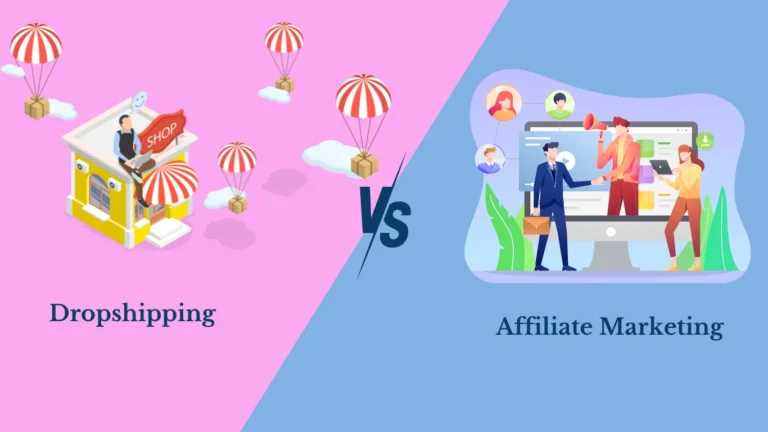
Dropshipping lets you sell products and make a profit, while affiliate marketing earns you commissions for promoting products. Both can be profitable.
- In affiliate marketing, earnings are based on commissions, and they can vary depending on the program and product being promoted.
- On the other hand, dropshipping allows you to set the retail price, which leads to greater profit margins.
- Both dropshipping and affiliate marketing models provide passive income profitability.
Which one is easier to start? - dropshipping vs affiliate marketing 2024 for beginners
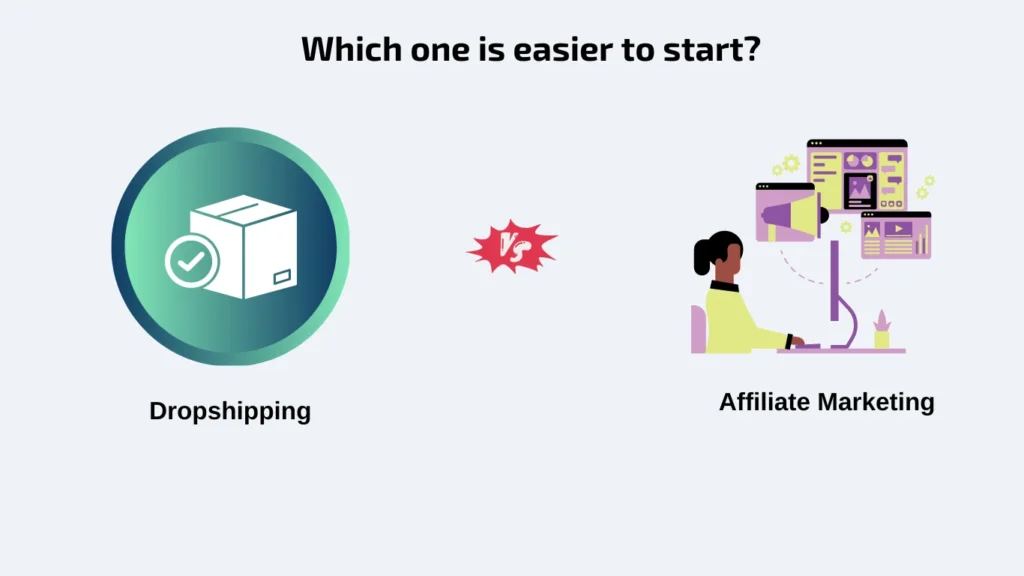
Both businesses are relatively easy to start. Affiliate marketing is generally easier to start than opening a dropshipping store, and you don’t have to worry about order fulfillment.
Dropshipping vs affiliate marketing can provide high profitability in both promoting and selling products.
Things to consider before start - Dropshipping vs Affiliate marketing
- Dropshipping presents lower risks compared to affiliate marketing. In dropshipping, retailers pay for merchandise only after a customer places an order, minimizing financial risks.
- It allows for higher profit margins as products are purchased at wholesale prices, and retailers can set their own retail prices.
- Cash flow is improved as payment is received instantly upon customer purchase. Moreover, dropshipping shops can offer competitive prices without investing in inventory or warehouse space.
- Conversely, affiliate marketing relies on merchants for product quality. It can involve low commission rates, limited pricing control, and the risk of program termination or reputational damage due to fraudulent practices.
- Also, Affiliate marketing earnings may be affected by issues like links being taken down or hacked, which can affect your earnings in affiliate marketing.
Combining dropshipping and affiliate marketing
Combining dropshipping and affiliate marketing can be a powerful strategy for maximizing your profits. You can earn both the affiliate commission and the profit margin from the sale by dropshipping products that you promote as an affiliate. This can be a win-win for both you and the customer.
Recommended Resources:
How does Qikink help beginners to start their dropshipping business?
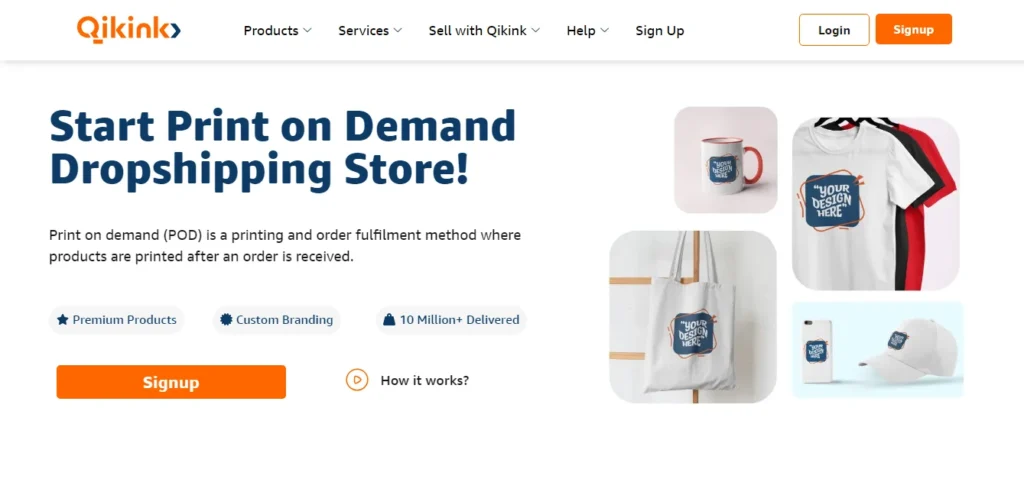
Qikink helps you to start your dropshipping business for free. You don’t have to worry about inventory management and shipping. Qikink handles everything from printing and packing to shipping directly to your customer address under your brand name.
Low-Risk Business Model:
Qikink provides a low-risk option for beginners entering the dropshipping business. We serve 7,000+ active online brands monthly and have fulfilled 1 million+ Print On Demand products across India.
No upfront investments:
Qikink is free for a lifetime, and payment is required only when a customer places an order. This allows beginners to start their dropshipping journey without any upfront costs or monthly fees. Entrepreneurs only pay for products when they receive orders, reducing financial risk.
Effortless Inventory Management:
Qikink efficiently manages inventory by printing products on demand, offering real-time tracking, and ensuring timely inventory replenishment.
Wide range of Product Selection:
Qikink offers a large print-on-demand catalog, allowing entrepreneurs to choose products that resonate with their target audience.
Easy Integration:
Qikink seamlessly integrates with Shopify and WooCommerce, providing access to a wide range of products, including apparel, accessories, and home goods.
Competitive Pricing:
Qikink provides competitive pricing, enabling beginners to set favorable prices and earn good profit margins.
Custom Branding Services:
Qikink offers custom branding services. You can use neck labels, hang tags, thank you cards, and free logo stickers printed with your brand name.
Once the order is received, Qikink does custom printing, branding, packing with accessories, and delivery to your customers under your brand name.
Final Thoughts
When deciding between dropshipping and affiliate marketing, your choice will depend on your specific preferences, available resources, and interests. Both options have advantages and disadvantages.
If you prefer a low-risk investment, you may opt for affiliate marketing. On the other hand, if you are comfortable with taking on more risk and seeking higher profit margins and revenue, dropshipping might be the better choice.
Additionally, by combining the two models, you can create a unique and profitable dropshipping business strategy that capitalizes on the strengths of both approaches.
Read more
Frequently Asked Questions
Can you do dropshipping and affiliate marketing together?
Yes, you can do both dropshipping and affiliate marketing together. By combining the two models, you can create a unique and profitable dropshipping business strategy that capitalizes on the strengths of both approaches.
Is affiliate marketing worth it?
Yes, Affiliate marketing is still worth it. Affiliate marketing is a profitable online business model with many earning opportunities.
- Once you establish yourself as an authority, you can sell various products. It’s cost-effective to start, as you don’t need to create products.
- Running it is simple and requires minimal technical skills. You need to convince others to buy the products you promote and earn commissions.
How to find suppliers for dropshipping?
We’ve compared India’s top 10 dropshipping suppliers to simplify your decision-making process. Our analysis covers product variety, shipping reliability, and more, offering valuable insights into the Indian dropshipping scene. Check out our 10 best dropshipping suppliers guide to find suppliers for dropshipping stores.
Can you make money dropshipping with Shopify?
Yes, you can make money on dropshipping with Shopify. Shopify provides a user-friendly platform that simplifies setting up an online store and managing sales.
How do you decide between affiliate marketing and dropshipping?
When choosing between dropshipping and affiliate marketing, your decision will be based on your personal preferences, resources, and interests. Both options come with their own pros and cons.
If you need a low-risk investment, affiliate marketing may be the way to go. However, if you are aiming for higher profit margins and revenue, dropshipping could be the better fit for you.

